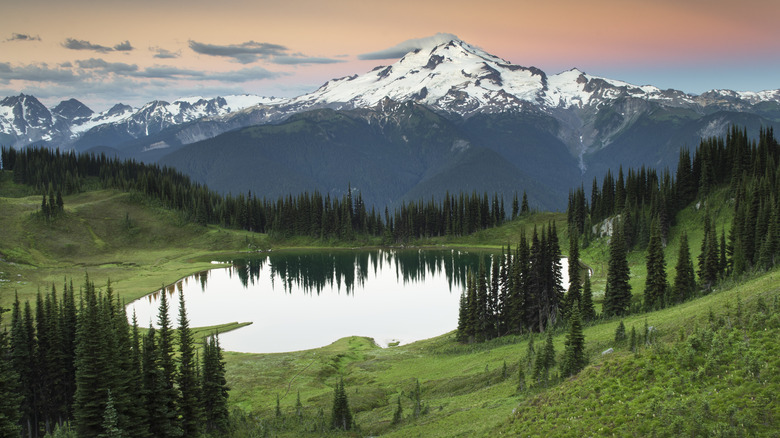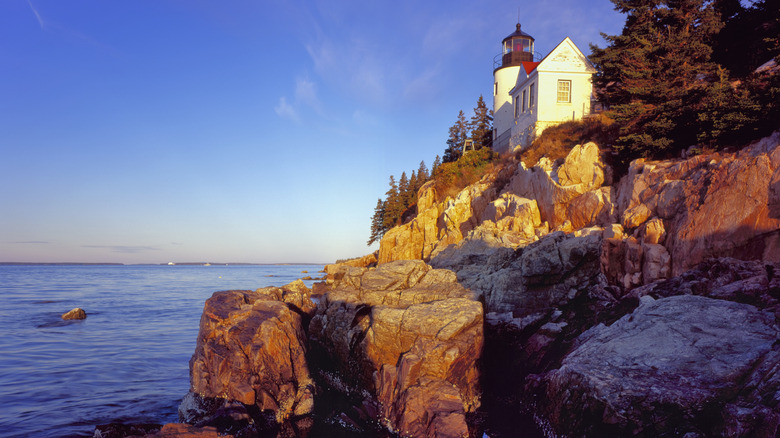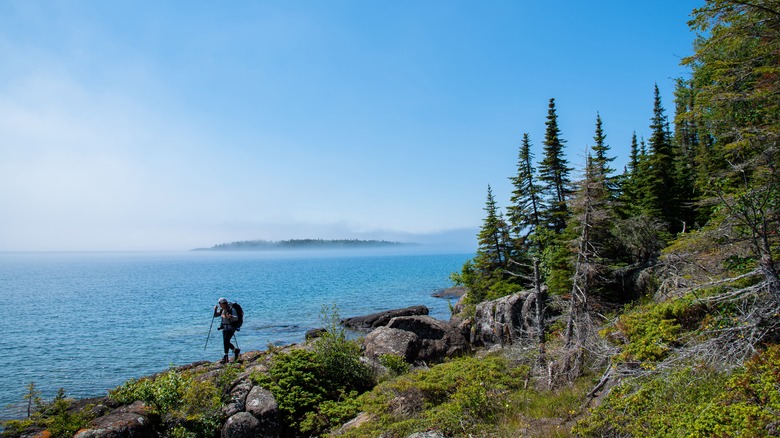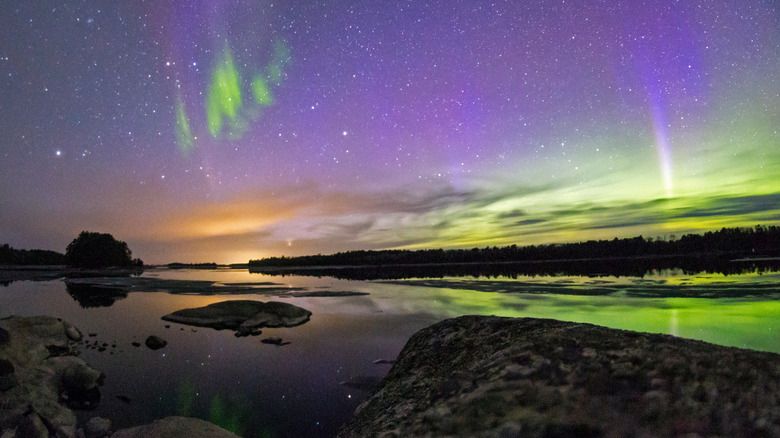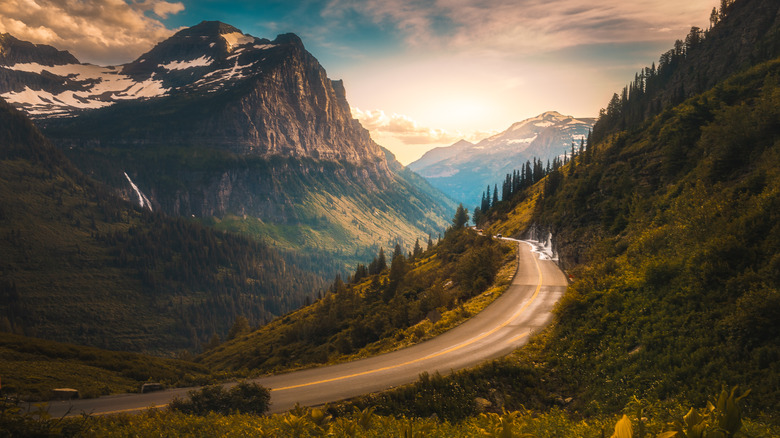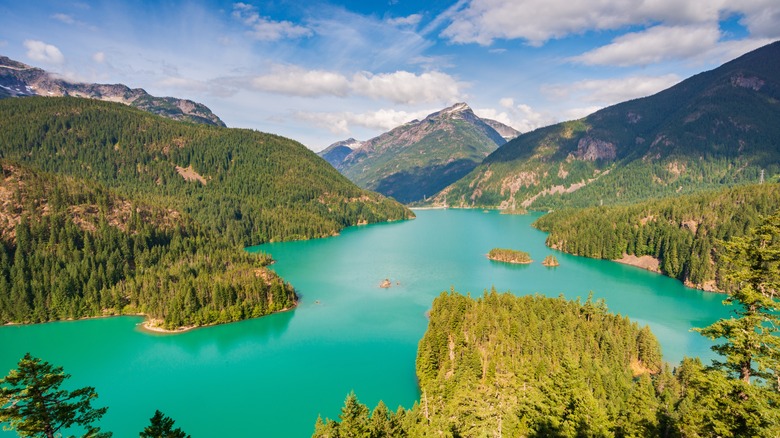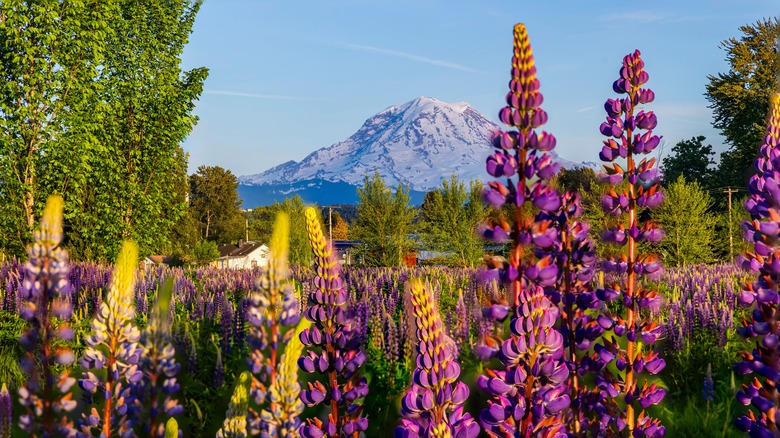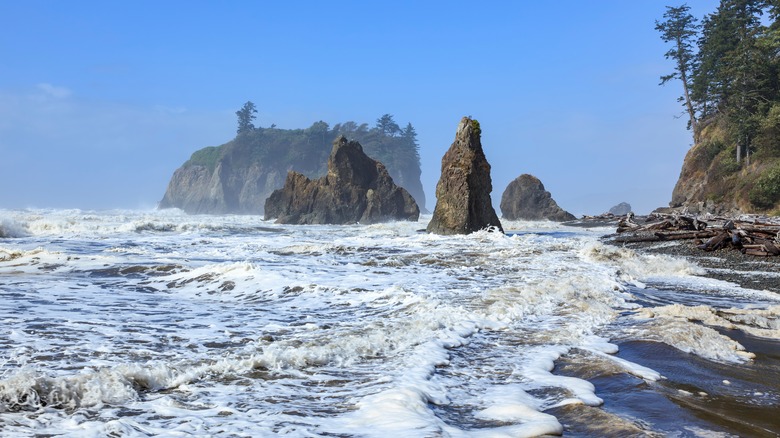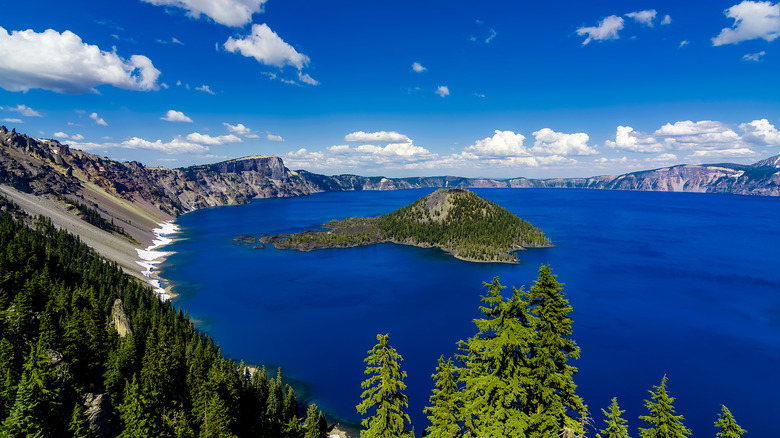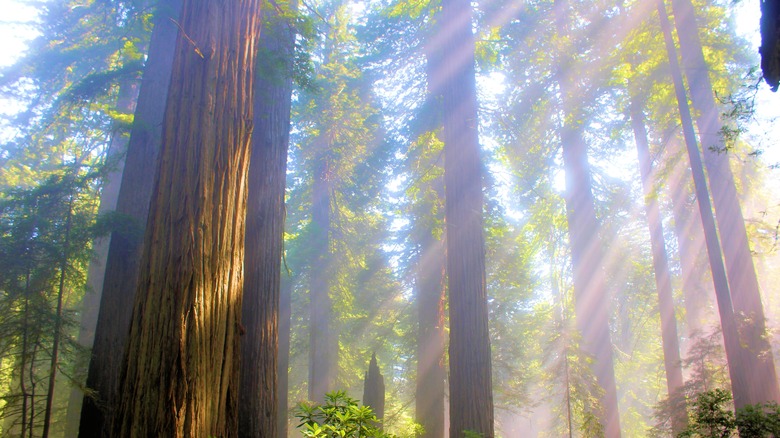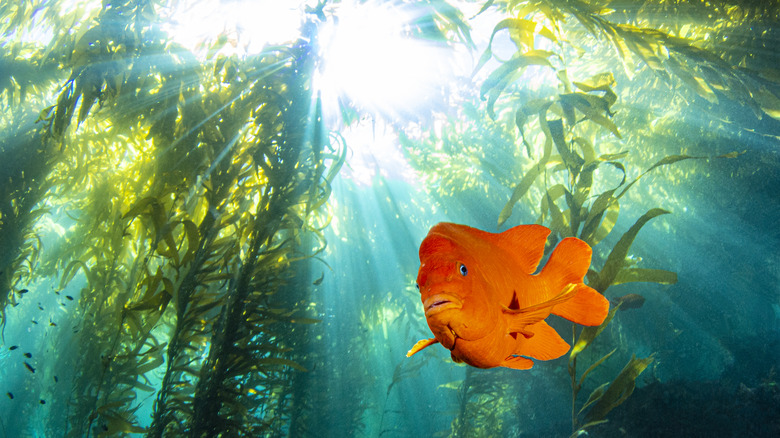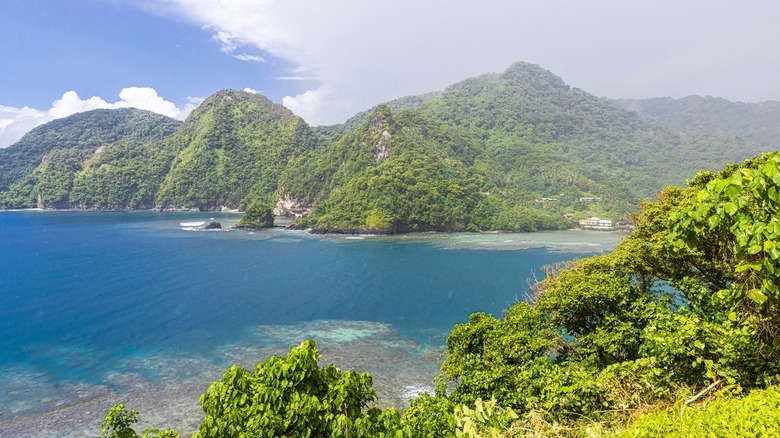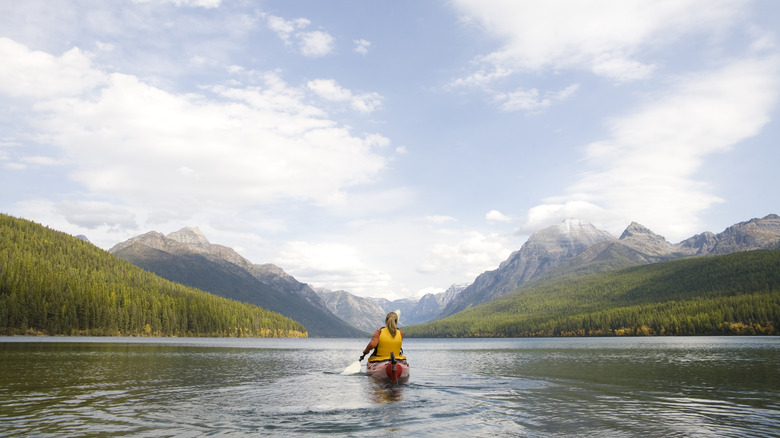The Best National Parks To Visit In August
When Charles Dickens wrote, "It was the best of times, it was the worst of times," he could have been describing American national parks in August. In August, the days are warm and long, granting you at least four extra hours of sightseeing. And more often than not, all the park's trails, tours, and amenities are open, so there's a lot more to see and experience. The scenery is lush and verdant, often bursting with flora and fauna.
But because it's the best of times, lots of other people show up. August is typically peak tourist season, meaning the trails will be packed, the lots will be full, and all the hotels, restaurants, tours, and campsites will be full. And in many places, August isn't just warm; it's blazing hot, sometimes dangerously so.
As you contemplate how to spend these last few weeks of summer break, we've compiled a list of beautiful national parks with reasonable crowds and temperatures. Many people flock to cooler parks in the summer months, so it was impossible to avoid crowds altogether, but we included some hacks to avoid the worst of them. We start in the northern forests and work our way down the temperate West Coast before ending up deep in the South Pacific — yup, you read that right.
Acadia National Park, Maine
Summers are best spent at the beach, and Acadia National Park is one of the country's best oceanside parks. Situated along the dense forests and rocky coasts of Mount Desert Island, Acadia is blessed by cool, salty sea breezes, quaint New England towns full of lobster and lighthouses, and majestic Cadillac Mountain, which sees the country's first sunrise every morning.
Unfortunately, many other people have realized what a perfect summer treat Acadia makes. In 2022, it was the country's fifth most-visited national park, attracting an impressive 312 million recreational visitors. Maine gets pretty cold in the winter, so July and August are the most popular months. On the one hand, this means that all the roads, trails, visitor centers, and campgrounds are open. On the other, it can mean huge crowds, traffic, limited parking, and limited vacancies.
If you plan to visit Acadia's more popular attractions — like Cadillac Mountain, Thunder Hole, and Park Loop Road — travelers recommend going either very early in the morning or after 5 p.m. They also recommend taking the free Island Explorer Shuttle, so you won't need to worry about parking. However, the park is also chock full of hidden gems like Seal Harbor Beach, Little Hunters Beach, and the entire Schoodic Peninsula, which features a loop road and numerous hiking trails. They also recommend visiting Mount Desert Island's much quieter western side and staying in towns like Southwest Harbor or Winter Harbor rather than the touristy Bar Harbor.
Isle Royale National Park, Michigan
While Acadia is one of America's five most-visited national parks, Isle Royale is one of its five least-visited. As soon as you start planning your trip to this archipelago of 450 islands in the middle of Lake Superior, you'll understand why. The islands are only accessible by ferries that take a minimum of three hours or seaplanes that cost at least $350. Once on the island, there are no cars, paved roads, or really much of anything except beautiful forests, lakes, mountains, and wildlife.
Many visitors agree that the summer is definitely the best time to visit Isle Royale. Much of the year is downright freezing, but in August, while much of the country bakes, highs usually only reach the upper 60s to mid 70 degrees Fahrenheit. The park is full of dense, leafy trails and ripe berries, and at night, the Northern Lights sometimes dance across the pristine skies.
For anyone who doesn't enjoy backcountry camping, the summer is also the only time of year when the park's two hotels, the Rock Harbor Lodge and the Windigo Camper Cabins, are open. It's also one of the few times a year when it's possible to comfortably hike, canoe, kayak, or take a beautiful boat cruise through the many Isle Royale islands and lighthouses. And though the park is at its busiest, at 850 square miles, it's more than possible to hike or boat for a while without seeing another soul.
Voyageurs National Park, Minnesota
For more North Country delights — with the possibility of Northern Lights thrown in — head west deep into the Land of 10,000 Lakes. Deep in the lakes and forests of northern Minnesota, Voyageurs National Park offers 214,000 acres of pristine forest surrounded by lakes and islands. Like Isle Royale, Voyageurs is one of America's lesser-known national parks, meaning that you can still enjoy delightful solitude even in the peak summer months. Voyageurs is known for its water activities, and with August highs averaging in the mid-70 degrees Fahrenheit, it's a prime time to get in your bathing suit and grab a paddle. The park boasts 655 miles of shoreline, and many of the campsites and hiking trails are only accessible by water. Experienced boaters can head out into any of the four major lakes or 26 smaller ones. During the summer, less experienced boaters can enjoy ranger-led boat tours.
But boating isn't limited to the daytime. Voyageurs is known for its houseboats, which can be booked through Airbnb or a number of different vendors. If you want a truly secluded lakeside experience, you can even book a private island. Back on dry land, hikers will enjoy 15 trails offering beautiful views of the forests and lakes. Voyageurs is also renowned for its night skies and is a designated International Dark Sky Park. It is also considered one of the best national parks to catch a glimpse of the aurora borealis, starting in late August.
Glacier National Park, Montana
Feel like "going to the sun" with some bighorn sheep or wolverines? Heading west to northern Montana, we arrive at Glacier National Park, spread out over 1 million breathtaking acres of mountains, lakes, forests, waterfalls, and, of course, glaciers. This "Crown of the Continent" ecosystem in the northern Rocky Mountains is home to some of the wildest and prettiest scenery on the planet, and in August, the wildflowers and wildlife are at their peak, and everything is wide open.
That also means that it's wide open to crowds. Glacier National Park can get up to 21,000 visitors per day in August, and reservations are required for many popular activities. This includes the iconic Going-to-the-Sun Road, a 50-mile road winding through the park's most beautiful scenery. As with many other popular sites and accommodations, reservations can be booked months in advance. Either book early or arrive before 6 a.m. or after 5 p.m., when reservations are not required. To bypass the need for reservations and expertly weave through the park's best spots, many travelers recommend booking a private tour.
Of course, the park is 1 million acres, so there are still plenty of spots off the beaten track. Many Glacier Valley offers a turquoise lake nestled among gorgeous mountains and the chalet-style Many Glacier Hotel. Temperatures will likely hover around the low 80 degrees Fahrenheit, so consider cooling down in one of the park's many bracing lakes, like Bowman Lake or Two Medicine Lake.
North Cascades National Park, Washington
The rugged fjords, waterfalls, and glaciers continue at North Cascades National Park, but this is beauty you'll get largely to yourself. For some strange yet wonderful reason, this exceptional park just 100 miles northeast of Seattle was the country's seventh least-visited national park in 2023, with just 40,000 visitors. It's also totally free, in both price and spirit. In August, the weather is already beautifully autumnal. Highs top out at about 70 degrees Fahrenheit and can sometimes drop to the 50s. It's mostly sunny, but occasional rain leads to dense green forests and an explosion of colorful wildflowers.
August is also the best time to take full advantage of the many trails traversing the "American Alps," a nickname given to the North Cascade mountains due to their high, jagged peaks that are snowy even in the summer. Popular trails include the Trail of the Cedars Nature Walk through beautiful, old-growth temperate rainforest, hikes around the beautiful Thorton and Rainy lakes, and the strenuous Desolation Peak trail, which rewards hikers with sweeping park views. It is a gorgeous experience.
While Glacier Park gets all the glacier glory, North Cascades has 300 of its own, one of the most in the lower 48. These glaciers have formed many gorgeous lakes, notably the brilliantly turquoise Diablo Lake. For the best look at all the park's wonders, drive along Highway 20, which offers several turnouts to marvel at the rugged glory all around you.
Mount Rainier National Park, Washington
On any clear day, all over Washington, you'll see a large wisp of white that you might mistake for clouds. That white may be in the clouds, but it's actually the snow-capped peak of what many locals call "The Mountain."Mount Rainier, also known by its Indigenous name "Tahoma," is the tallest singular peak in the lower 48, soaring 14,410 feet above the glaciers, forests, waterfalls, and wildflower-strewn meadows that surround it. Mt. Rainier National Park, located about 165 miles south of North Cascades National Park and 60 miles south of Seattle, is the 236,000-acre park surrounding the mountain. In August, all the trails are open, and marmots and mountain goats prance through a mindblowing, multicolored mosaic of wildflowers. Temperatures remain comfortably in the 60s.
It isn't just marmots and mountain goats in the meadows. Unlike North Cascades, Mt. Rainier is one of the country's most popular parks, and it can get packed. The National Park Service recommends visiting either on weekdays, early mornings, late afternoons, or via the White River Road entrance.
The crowds are there for a reason: The scenery is simply stunning. The Pinnacle Peak Trail meanders through a wildflower-covered path with breathtaking mountain views. The Skyline Trail takes hikers on a soaring journey through waterfalls, forests, and meadows, accompanied by wildlife and views of Mt. Rainier and nearby mountains. And if you're feeling feisty and have 10 to 12 hours to spare, why not continue the journey and climb Tahoma herself?
Olympic National Park, Washington
Olympic National Park is one of the only spots in America where you can stand atop a mountain and watch the rainforest kiss the ocean. This tantalizingly diverse park on Washington's stunning Olympic Peninsula contains four different regions: the Pacific coast, the temperate rainforest, the mountains, and an alpine region in the center of the peninsula. This breathtaking biodiversity has made Olympic National Park a UNESCO World Heritage Site and a Biosphere Reserve. It also attracted 2.9 million visitors in 2023, the 10th highest in the country's national parks. Unsurprisingly, the majority of these visitors come in the summer when the epic "Wet Coast" rains subside, everything's open, and the wildflowers are in full bloom. Highs usually range between the low 60s and mid 70 degrees Fahrenheit. If you want to avoid crowds, visit before 10 a.m. or after 2 p.m. and take the park's free bus when possible.
The park's most popular attractions include Hurricane Ridge, a magnificent trail overlooking miles of towering snow-capped mountains, dense evergreen forests, and lavender-colored meadows. Visitors also flock to the Hoh Rainforest, a mossy, misty, mystical forest turned dazzling green by the hundreds of inches of rain it gets each year. Although August is one of the drier months, there are still plenty of enchanting places to get wet, like the powerful Sol Duc or Marymere Falls, the brilliant cobalt Lake Crescent, or the towering sea stacks along Shi Shi and Rialto beaches.
Crater Lake National Park, Oregon
Speaking of brilliant cobalt lakes, let's travel deep into Oregon's only national park for THE brilliant cobalt lake. Crater Lake is the deepest lake in America and the seventh deepest in the world, plunging 1,949 feet. It was formed when a 12,000-foot volcano erupted and collapsed, causing a deep crater that filled with rain over the ensuing millennia. Because Crater Lake has no tributaries flowing into it and not much algae, it is also one of the world's cleanest, clearest lakes. It perfectly reflects the sky and glows a deep, mesmerizing blue.
Crater Lake National Park is only 20.6 square miles, so even if it's not one of the country's most visited national parks, it can definitely feel crowded during its peak summer season. Still, August is a wonderful time to visit. Temperatures hover comfortably in the upper 60s to mid-70 degrees Fahrenheit, and wildflowers abound.
In addition to the many trails, visitors have a number of delightful ways to enjoy views of the lake, including driving the 33-mile Rim Drive around the lake's circumference or taking a guided trolley tour. Summer is also the only time of year when you can take a boat to Wizard Island in the middle of the lake. At the bottom of the steep Cleetwood Cove Trail, hardy visitors can swim in the lake's notoriously chilly waters. In addition to several other trails circling the lake, the park also offers the joys of old-growth forests and waterfalls.
Redwood National and State Parks, California
We now travel from America's deepest lake to its tallest trees. In the far northwest corner of California, 139,000 acres are set aside to protect 45% of the world's remaining coastal redwood trees. These majestic masterpieces are often roughly 350 feet tall and 1,000 years old. A hidden 380-foot tree named Hyperion is the tallest tree in the entire world, but conservationists are so worried about the impact of too many visitors that anyone who even gets close to the tree can face up to six months in jail and a $5,000 fine.
But don't panic: Redwood National Park and three adjacent state parks are also home to scores of trees just a few inches shorter that are perfectly legal to view in wide-eyed amazement. In August, temperatures hit the high 60 degrees Fahrenheit, and the mornings are often cool and foggy. August is one of the most popular months to visit, but crowds are nowhere near what you'd find at places like Yosemite National Park or Yellowstone.
There will be mighty, magical redwoods everywhere you look, but some spots are unusually special. Famous clusters include the Tall Trees Grove, home to many of the tallest trees in the world, and Stout Memorial Grove, where some trees are roughly 2,000 years old. To look down on the spot where the world's tallest, oldest trees meet some of the world's most gorgeous beaches, head to the Klamath River and Redwood Creek overlooks.
Channel Islands National Park, California
Most people would agree it's worth a little extra fuss in order to swim with a sea lion under a volcanic sea arch. "A little extra fuss" might be a slight understatement when it comes to visiting the Channel Islands, an archipelago of five uninhabited islands about 25 miles off the coast of southern California. But if Jacques Cousteau says a place is one of the top diving spots in the world, you pack up your mask and wetsuit, and you book the next ferry.
The Channel Islands rank among America's least-visited national parks, but ferries, seaplanes, campsites, and snorkeling and kayaking tours book up quickly during the peak summer season. If you want to visit in August, start making reservations in January. As soon as the Island Packers ferry docks, you'll be glad you did. The weather is usually perfect in the mid-70s. The water is also typically at its warmest, calmest, and clearest, meaning you'll likely get extra clear vision of an abundance of marine life. You might see a seal swimming through a teal kelp forest, with a school of bright orange Garibaldi fish right behind. Water activities draw the most enthusiastic traveler reviews, but the islands also offer 390 square miles of virtually untouched wilderness. Well-marked trails traverse miles of majestic oceanside bluffs, which hikers share with more than 2,000 different species — over 150 of which can't be found anywhere else on the planet.
National Park of American Samoa
If you're snorkeling at the Channel Islands and suddenly find yourself very much adrift, don't despair: you could end up in American Samoa. If you do somehow manage, "Life of Pi" style, to travel 4,700 miles across the Pacific and land in this tropical paradise, consider yourself very lucky. In the United States, national parks tend to conjure images of lakes, pine forests, or fiery red rock formations rather than tropical beaches and rainforests. But American Samoa, a series of five volcanic islands and two coral atolls about halfway between Hawaii and New Zealand, is a U.S. territory containing a 13,500-acre national park spread over three islands. It's a trek and a half to get there, making the park the U.S.'s second least-visited. But once you finally make it, you'll be richly rewarded with mind-blowing beaches, paleotropical rainforests, and coral reefs. You'll also be blessed with a warm local culture and vibrant flora and fauna, from rare sea turtles to a fruit bat called the "Samoan Flying Fox."
In August, highs average about 80 degrees Fahrenheit each day, which is perfect for all the swimming and snorkeling in the warm, crystal blue waters and dazzling, kaleidoscopic coral reefs. If you only see one beach, go with Ofu Beach, a near-private, picture-perfect turquoise beach and coral reef. The park also includes numerous trails granting panoramic paradise views, like the 7-mile Mount Alava Trail.
Methodology
We searched through different blogs, articles, and trail and weather reports to find parks that aren't too hot, aren't too crowded, and are full of spectacular scenery, activities, and accommodations. We couldn't avoid crowds altogether, but if a house is packed, the show is probably good. You've got to work pretty hard to have a bad time in a national park, after all.
